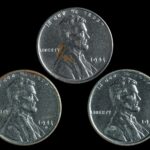The 1964 Lincoln penny remains a popular coin among collectors. Its value depends on several factors, including its condition, rarity, and any existing errors. While common in circulation, well-preserved or error-filled 1964 pennies can be surprisingly valuable.
Understanding 1964 Penny Values
The value of a 1964 penny is determined by a few key elements:
- Condition: The better the condition of the coin, the more it’s worth. Coins are graded on a scale, with higher grades indicating less wear and tear.
- Mint Mark: Pennies were minted in Philadelphia (no mint mark) and Denver (“D” mint mark).
- Patina: The color and tone of the coin’s surface, known as patina, can significantly impact its value.
1964 Penny Value Chart
Here’s a general overview of 1964 penny values based on grade and mint mark:
| 1964 Penny Value Chart (Includes D) | |||||
|---|---|---|---|---|---|
| MS63 | MS64 | MS65 | MS66 | MS67 | |
| 1964 Penny BN (Brown) Philadelphia | $- | $- | $- | $1 | $- |
| 1964 Penny RB (Red-Brown) Philadelphia | $- | $- | $2 | $20-40 | $- |
| 1964 Penny RD (Red) Philadelphia | $3 | $5-6 | $10-12 | $20-65 | $950-13,500 |
| 1964 D Penny RB (Red-Brown) | $- | $- | $2 | $- | $- |
| 1964 D Penny RD (Red) | $3 | $5-8 | $20-22 | $30-85 | $450-4,750 |
Source: NGC
Note: MS stands for Mint State, indicating an uncirculated coin. The numbers (63-67) represent the grade of the coin. BN, RB, and RD refer to the color of the coin (Brown, Red-Brown, and Red).
Patina: A Key Factor
For 1964 Lincoln cents, the patina is a crucial factor. The patina is the result of the metal’s oxidation from exposure to air and other elements, resulting in different tones or colors. An original patina, developed over the coin’s lifespan, is highly prized by collectors. Avoid cleaning coins without expert advice, as it can significantly decrease their value.
Types of Patina on 1964 Lincoln Pennies
Due to its high copper content (95%), the 1964 penny exhibits three primary patinas:
-
BN (Brown): The most common patina, giving the coin an aged appearance.
Source: NGC
-
RB (Red-Brown): This patina retains some of the reddish tones of a newly minted copper coin. It indicates better environmental preservation than the brown patina.
-
RD (Red): This is the original red color of a newly minted copper coin. It is the rarest and most valuable patina.
Source: PCGS
Historical Context: The 1964 Penny
The 1964 Lincoln cent is made of 95% copper and 5% zinc, weighing 3.11 grams with a diameter of 19 millimeters. In 1959, the U.S. Mint replaced the familiar Wheat Reverse with a design commemorating the Lincoln Memorial. The year 1964 stands out due to its high mintage figures, making certain errors more noticeable and potentially valuable.
Mint Marks and Mintage Figures
The 1964 pennies were produced at two U.S. Mints:
- Philadelphia (No Mint Mark): 2,648,575,000 pennies were struck.
- Denver (Mint Mark “D”): 3,799,071,500 pennies were struck.
The mint mark is located below the date on the coin.
Factors Influencing Value: Condition, Errors, and Rarities
A coin’s grade significantly impacts its value. Higher grades mean higher prices, especially for coins that circulated frequently, like pennies. To assess a coin’s condition, it’s best to consult a professional grading service like PCGS, NGC, ICG, or ANACS. These services evaluate and grade coins, certify authenticity, and encapsulate them for preservation and sale.
Rare 1964 Penny Errors
While most 1964 pennies are common, certain error coins can be quite valuable. Here are a few notable examples:
1. 1964 Penny SMS (Special Mint Set)
These coins are believed to be prototypes for the SMS minted between 1965 and 1967. Between 20 and 50 SMS coins are thought to exist. A 1964 1C SMS SP67 RD sold for $15,600 in 2019.
2. 1964 Penny Triple Saddle Strike
This error features multiple minting, resulting in three images of Lincoln on the same penny. A 1964 penny MS64 RB with this error sold for $1,440 in 2020.
Source: HA.com
3. 1964 D Penny Struck Over 1963 D Penny
This error occurred when a 1964 Denver penny was minted over a 1963 penny from the same mint. An MS64 BN example sold for $4,312.50 in 2009.
Identifying a 1964 SMS Penny
If you suspect you have a 1964 SMS penny, look for these characteristics:
- Sharp strikes: The design will appear sharper and more defined than on a regular 1964 penny.
- Satin finish: The surface will have a matte-like finish.
- Toning: The copper may have toned to a red or brown hue.
- Edge: The edge will have a square rim, unlike the rounded edge of a regular penny.
- Mintmark: It will have a “D” mintmark, indicating production at the Denver Mint.
Recent Auction Values
- In 2023, a 1964 1C Doubled Die Reverse, FS-802, MS64 Red was auctioned for $384.
- In March 2024, two 1964 1C Double Die Reverse, DDR-001, MS64 Red ANACS coins sold for $95 and $91.
Final Thoughts
While most 1964 pennies hold minimal value, rare errors and well-preserved examples can be worth a significant amount. Examining your pennies could turn up a valuable find. Even common 1964 pennies with attractive patina can be a worthwhile addition to a Lincoln Cent collection. If you believe you have a rare 1964 penny, consider having it authenticated and graded by a professional coin grading service.
